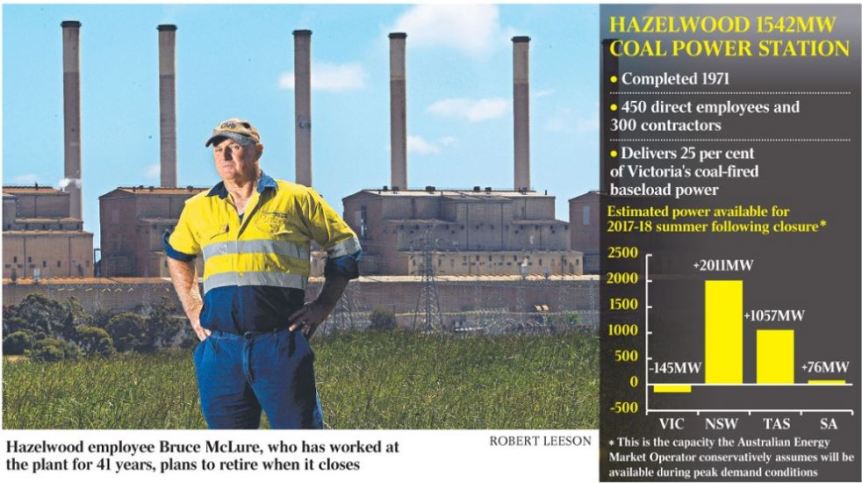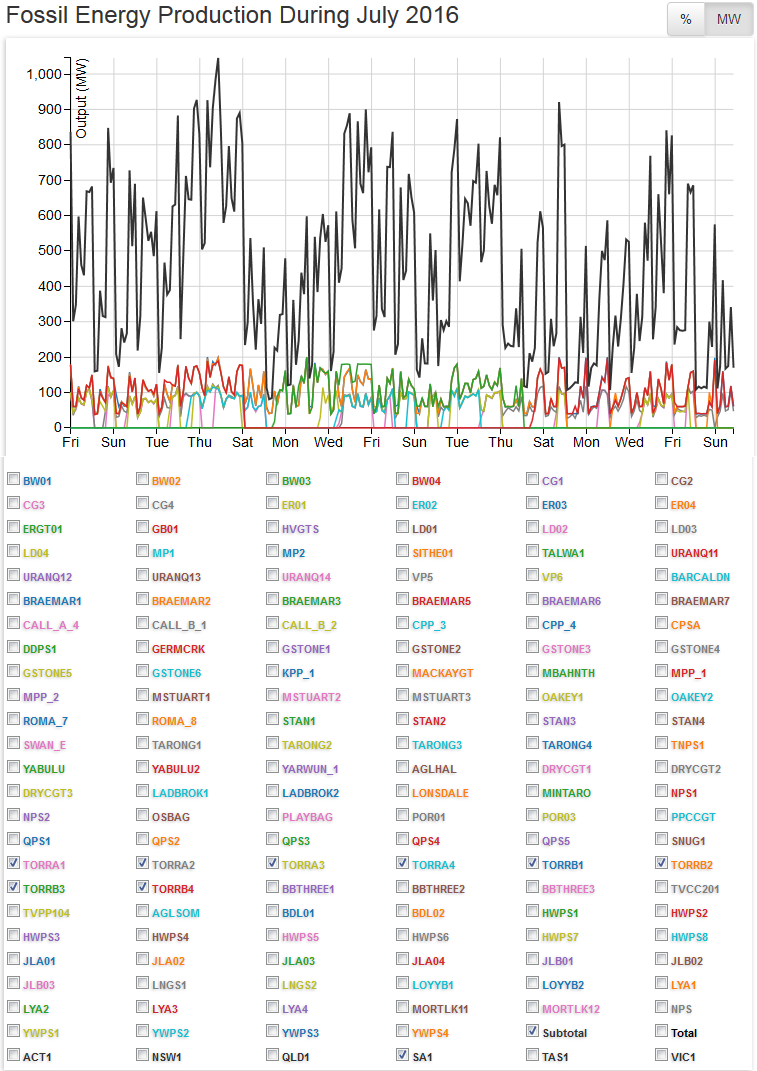***
To call what Australian politicians refer to as energy “policy” is to flatter it as involving some kind of deliberate design.
As things have panned out in South Australia, and are fast panning out in neighbouring Victoria, there is only one fair description: “total chaos”.
South Australia lost 784MW of reliable, affordable base-load power when Alinta determined to close its Port Augusta power plants in May this year. That decision was driven by an inability to dispatch power to the grid in relation to daily demand and, accordingly, to make a fair return on the employment of their assets.
As a result of the REC subsidies paid to wind power outfits under the Federal government’s Large-Scale RET (the value of which underpins the guaranteed fixed prices in their PPAs with retailers of around $110 per MWh), whenever the wind blows in South Australia, wind power outfits were able to underbid Alinta (on plenty of occasions paying the grid manager to take their skittish wares) which inevitably killed their profits and drove them out of business.
The same perverse market conditions still exist and result in its last remaining base-load plant, AGL’s Torrens Island operation being forced out of the market every time the wind picks up (see below and our post here):
Now, the Federal LRET has just claimed another scalp; well, more like 1,000 of them – well-paid blue-collar jobs, not to mention an entire regional community where decent jobs are a rare luxury for most.
However, the LRET’s casualties will not end there: with the loss of Hazelwood’s reliable 1,600MW of base-load capacity, Victorian power prices are bound to rocket – a 25% jump is tipped just for starters – which will inevitably result in the loss of another 800 jobs at Portland’s aluminium smelter and crush the life out of, yet another, regional community.
Here’s The Australian’s Judith Sloan with an initial body count.
How Australia shot itself in the foot: a cautionary tale of RET folly
The Australian
Judith Sloan
4 November 2016
One of my friends wants me to write a book titled “How Australia Shot Itself in the Foot”.
She thinks climate change and energy policy would be a major chapter. She wouldn’t be wrong.
So another coal-fired power station, Hazelwood in Victoria’s Latrobe Valley, is about to bite the dust. That’s another 1600 megawatts or 20 per cent of Victoria’s baseload capacity gone. In all, 3500MW of baseload capacity will have been lost this decade along the east coast.
The consequences could have been even more disastrous were it not for the substantial fall in demand for electricity, partly associated with soaring prices and the loss of manufacturing.
With Hazelwood gone — and almost 2000 well-paid direct and indirect jobs lost — wholesale electricity prices will rise. The Victorian government is attempting to spin the story, suggesting the price hike will be in the range of 4 to 8 per cent. Industry experts put a figure close to 25 per cent. We know from the experience of the closure of the Northern coal-fired power station in South Australia that the industry experts are likely to be closer to the money.
The spinmeisters in the Victorian government will also be busy explaining the closure of the aluminium smelter in Portland and thousands of jobs. “Nothing to do with renewable energy” will doubtless be the message.
Mind you, the Greens will be celebrating these developments, pointing to the thousands of jobs that will be created in the renewable energy sector while forgetting all those that are lost, particularly as a result of rapidly rising electricity prices.
Here’s the thing: the close of Hazelwood is a direct consequence of the hare-brained Renewable Energy Target which imposes extremely high costs on the economy for the carbon dioxide abatement achieved. It’s hard to think of a worse policy intervention. Because renewable energy is so favoured under the arrangement in terms of bidding and dispatch, low-cost baseload sources such as Hazelwood are driven out of the market even though backup sources are needed to cope with the intermittent nature of wind and solar power
It’s not that Hazelwood is a particularly old plant — with maintenance and upgrading, it could have kept going. But the RET has made the plant unprofitable. No owner could tolerate this for long.
But here’s another crazy thing about the RET: consumers will end up paying higher prices for nothing, as there is no way that the revised target of 33,000 gigawatt hours for large-scale renewables by 2020 will be met. We are only at half that rate now and there is no way that a sufficient number of projects can be developed in that time.
The market knows this, which is why the price of the underlying certificates has risen sharply in recent months. A number of companies will just end up paying the shortfall charge rather than invest in renewable energy projects. The rent-seekers in the renewable energy sector are now complaining that the RET isn’t enough — it continues on to 2030 — and want even more assistance.
The closure of Hazelwood is obviously very bad news for the local workers affected. All those millions of dollars that the federal and state governments will throw at the region will achieve very little apart from serving the political purpose of demonstrating that the governments care.
This is also very bad news for South Australia, whose only interconnection is with Victoria. The folly of its excessive reliance on renewable energy and the associated fragility of its network will be further exposed, as its scope to rely on Victoria for much-need baseload backup will be reduced by the closure of Hazelwood.
It’s all very well saying that an interconnector should be built to NSW, but this takes time and a lot of money that inevitably is paid for by consumers. The fact that BHP-Billiton has effectively warned that any expansion of the Olympic Dam mine is contingent on reliable and affordable electricity is a clear shot across the bow of the Weatherill government.
The real tragedy is that the obvious path to a lower emission electricity system based on gas and high-efficiency, low-emission coal plants has been deemed impossible by the adoption of deeply flawed policy.
The Australian
Judith Sloan absolutely on fire in that analysis. And it’s worth highlighting another of her observations on the fact that there is no way on earth that the target set by the LRET will ever be met:
But here’s another crazy thing about the RET: consumers will end up paying higher prices for nothing, as there is no way that the revised target of 33,000 gigawatt hours for large-scale renewables by 2020 will be met. We are only at half that rate now and there is no way that a sufficient number of projects can be developed in that time.
Judith, a classically trained economist and master of understatement, probably fails to appreciate the political significance of her statement that “consumers will end up paying higher prices for nothing”.
With people like Judith Sloan repeatedly drawing attention to the obscene cost of the LRET – which is quite easily the single biggest government mandated wealth transfer in the history of the Commonwealth – it’s only a matter of time before the politics of the ‘real’ catches up with the cruel fantasy of ‘policies’ like the LRET.
While there is always plenty of talk in the press about the numbers of voters said to be in ‘favour of renewables, every survey that has ever been done in this Country makes it plain that no one is prepared to pay any more than they are already paying for power in order to obtain the ‘touchy-feely’ stuff. Feeling “green” is fine, provided no one has to pay for it (see this piece from JoNova).
When Australian power consumers finally rumble the fact that at least half of the $45 billion that is to be added to their power bills under the LRET, is nothing more than a fine – and that a figure in the order of $20 billion will end up going straight into general revenue – without adding a single so-called “clean, green” watt to the grid – there will be more than just a little consternation out there in voter land. These people will be furious. Josh Frydenberg and his boss Malcolm Turnbull can bank on it.

Liberals, Nationals & Labor – where’s One Nation on the ticket?



Hi,
I started a PETITION “SA PREMIER JAY WEATHERILL : Demand the RESIGNATION of the Energy Minister for HIGH POWER PRICES CAUSING SA’s JOBS CRISIS and 15,000 household POWER DISCONNECTIONS, frequent POWER BLACKOUTS and the JULY 2016 POWER CRISIS” and wanted to see if you could help by adding your name.
Our goal is to reach 100 signatures and we need more support.
You can read more and sign the petition here:
https://www.change.org/p/sa-premier-jay-weatherill-demand-the-resignation-of-the-energy-minister-for-high-power-prices-causing-sa-s-jobs-crisis-and-also-15-000-household-power-disconnections-frequent-power-blackouts-and-the-july-2016-power-crisis?recruiter=135406845&utm_source=share_petition&utm_medium=email&utm_campaign=share_email_responsive
Please share this petition with anyone you think may be interested in signing it.
Thankyou for your time.
Our intro to your piece, STT, given that the hangers-on and self-appointed energy advisers are once again plastering the press with misleading information on renewables’ efficacy during the month of October:
South Australia could twin with Scotland. Who can come up with the bigger shambles; closing conventional stations, causing blackouts, costing a bomb, leading to lack of energy security while at the same time crowing about what wonders renewables are doing.
Scotland and SA – both have disappeared down the rabbit hole.
Take a look at gridwatch at around 5.15 pm UK local time, this evening the only spare capacity was the OCGTs, and winter has not started yet, some engineers warned about closing Longannet coal-fired power station, but were ignored:
http://www.gridwatch.templar.co.uk/
Interesting that Campbell Gemmell has been the head of both Scotland and SA’s EPAs in recent years.
The ‘estimates’ for lost jobs re the likely Portland Alcoa aluminium smelter closure is 1,000. This in a population of under 10,000 for Portland in South West Victoria represents one quarter of the total population.
According to Michael Parker, Alcoa chairman and managing director, “Australia is losing its competitive advantage when it comes to energy “. Wake up Australia.
Reblogged this on Climatism and commented:
Australia shuts down its once proud – cheap, efficient, baseload reliable coal-fired sources of energy in favour of massively expensive, intermittent, un-green, unwanted, ideologically-driven, weather dependent “unreliable” wind and solar energy?!
Meanwhile, China and India are placing online a coal-fired power plant every week. Holland and most of Eastern Europe are locking in cheap, reliable, efficient coal, and ideologically “green” Germany is currently undergoing the biggest coal-fired power expansion in her history, despite spending (wasting) nearly €1 trillion euros on “unreliables”!
Australia’s crazy move to shut down coal-fired power, all thanks to the great (yet to be empirically proven) “global warming” scare, ideologically pushed by Leftist mainstream media and minority activist green groups and government scientists.
By doing this, Australia is simply sending jobs and supposedly ‘dangerous’ CO2 emissions off-shore to places, like China and India.
Third-world countries doing Australia’s manufacturing, with its coal, under dodgy environmental particulate (real pollution) regulations, all so Australia can meet some fanciful “renewable energy target” (RET) that NO one can still yet answer the simple question “by how much will all the pain lower the temperature of the planet” !?
Insanity on an insane level.